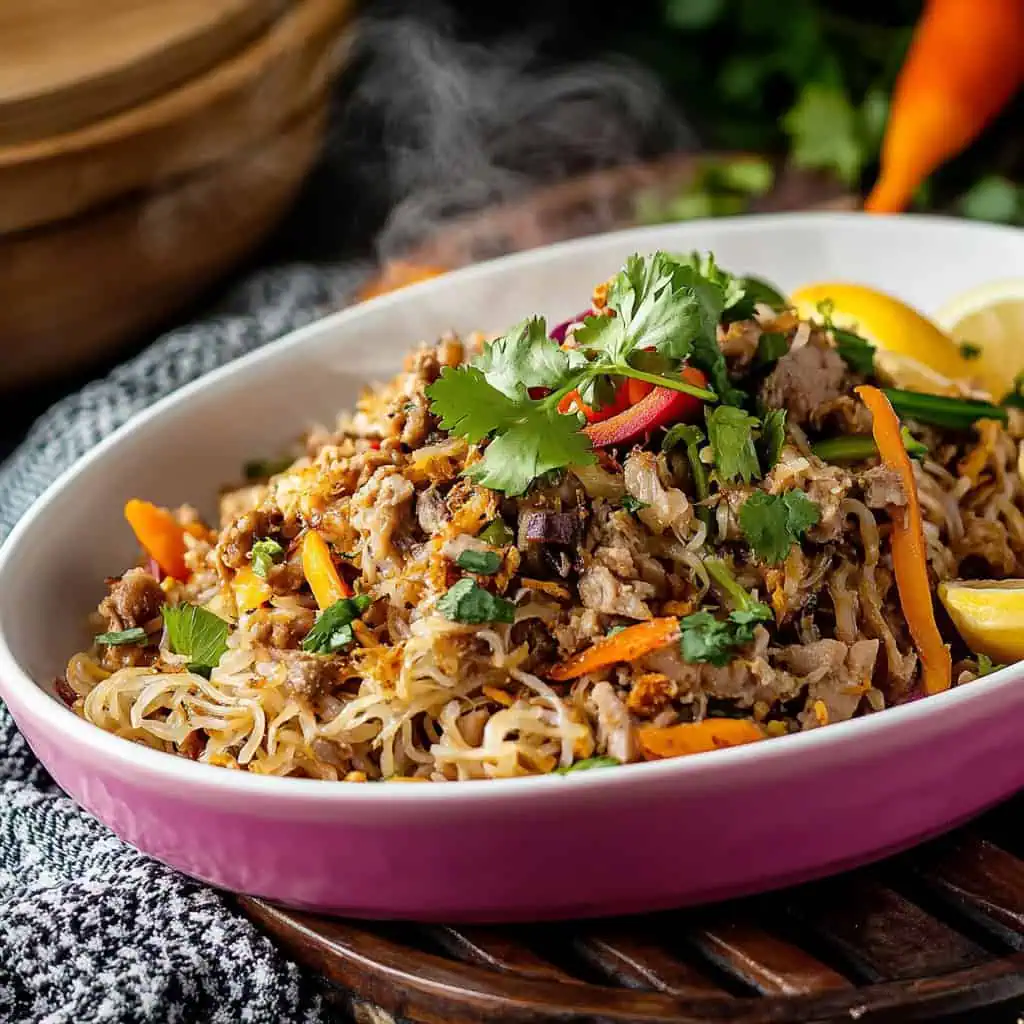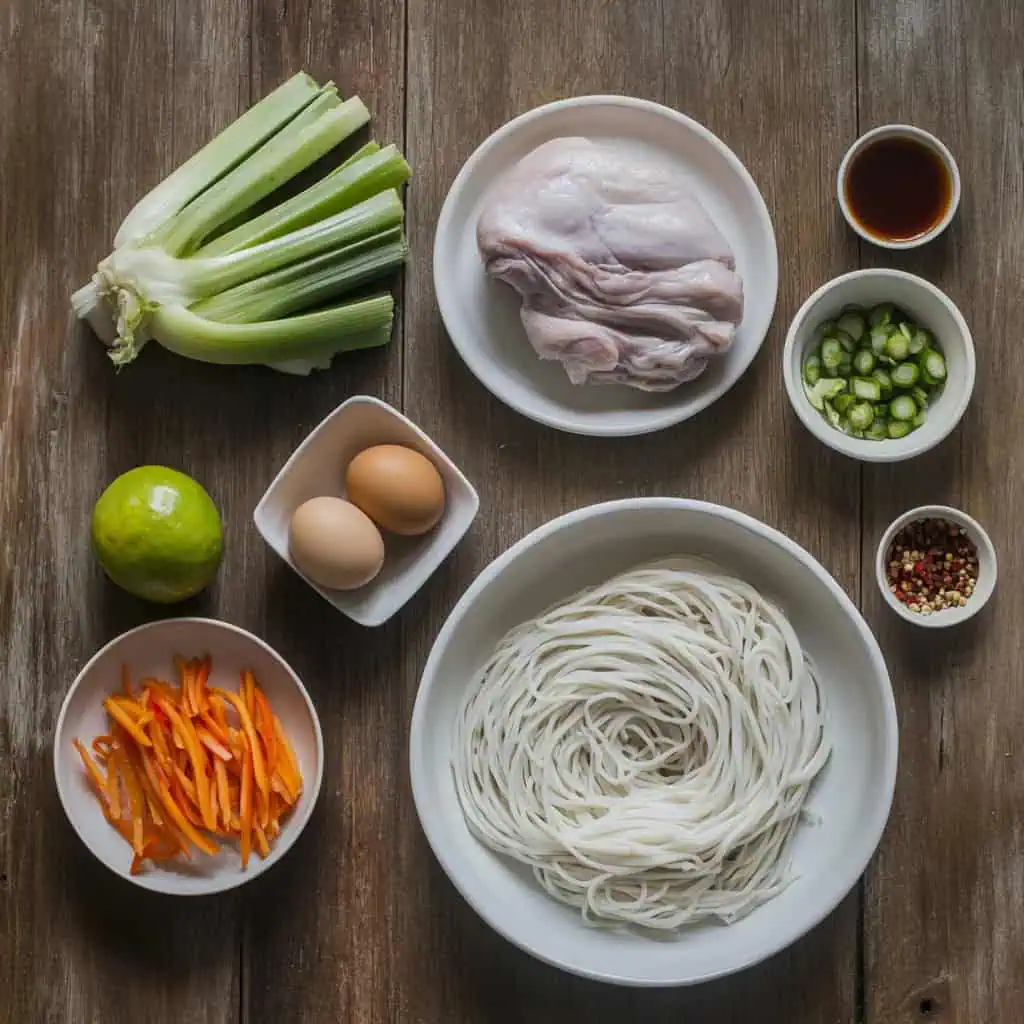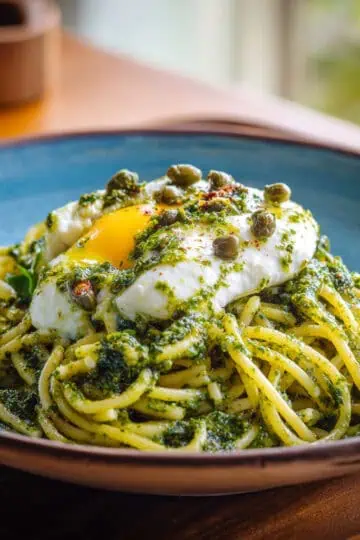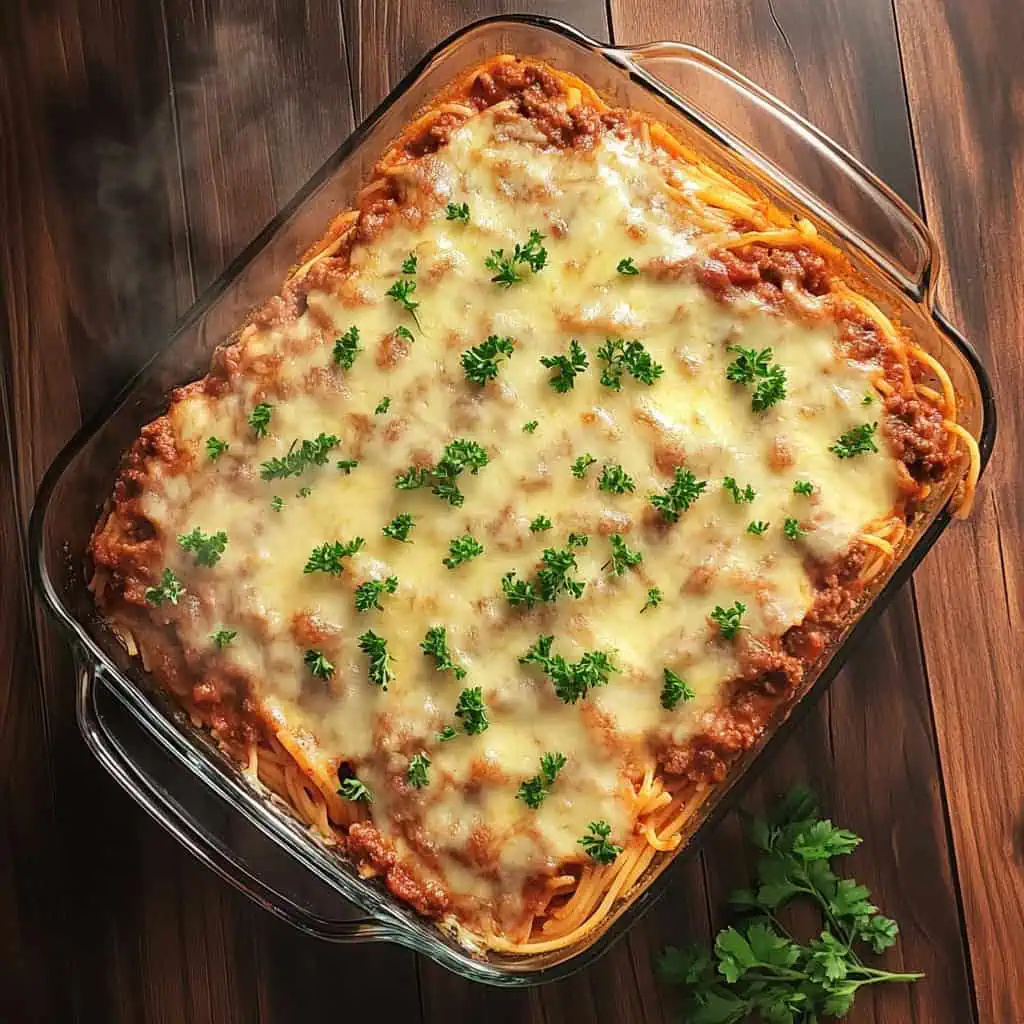You know what I absolutely love about Filipino food? We're not afraid to mix things up and create something amazing. This Pancit Sisig is the perfect example of what happens when you take two party favorites and bring them together in one epic dish.
Picture this: your favorite pancit bihon – those delicate rice noodles stir-fried to perfection – crowned with hot, sizzling sisig that's crispy, tangy, and absolutely irresistible.
I first tried this at a food park in Manila and honestly couldn't believe how well these two classics work together. The way the citrusy, crispy pork mingles with the savory noodles is pure genius. It's like your favorite pulutan (bar food) had a delicious love child with your go-to party noodles!
Jump to:

Why You'll Love This Recipe
- Perfect fusion of two beloved Filipino dishes
- Creates an impressive party centerpiece
- Combines different textures: crispy pork, tender noodles, and fresh vegetables
- Can be prepared ahead of time
- Customizable spice levels
- Great for using leftover sisig
- Perfect balance of savory, tangy, and umami flavors
Ingredients
The ingredients in this pancit sisig are carefully selected to create a harmonious blend of flavors and textures. Pork neck and jowl provide the perfect balance of meat and fat for a crispy yet succulent sisig, while the baking soda treatment ensures crackling-crisp skin.
Birds eye chilies and calamansi juice add the signature heat and tanginess that make sisig irresistible. For the pancit, the delicate bihon noodles create a neutral canvas that absorbs the savory chicken broth, while the colorful mix of cabbage, carrots, and Chinese celery adds freshness, crunch, and visual appeal.
The combination of soy sauce and fish sauce creates depth without overwhelming the dish, allowing both components to shine individually while creating something greater together.

For the Sisig:
- 1 kg whole pork neck and/or jowl (liempo), skin on
- 1 medium onion, peeled and diced
- 4 birds eye chilies (siling labuyo), minced
- ½ cup calamansi or lemon juice
- 4 cloves garlic, minced
- ½ thumb-sized ginger, minced
- 3 tablespoon Filipino soy sauce
- 1 teaspoon baking soda
- Salt
- Freshly ground black pepper
- Oil
- 2 fresh eggs
For the Pancit:
- 500 g pancit bihon noodles
- 2 cups chicken broth
- ¼ cabbage, sliced
- 1 red onion, sliced
- 4 cloves garlic, minced
- 1 carrot, sliced
- ¾ cup Chinese celery, chopped
- ⅓ cup Filipino soy sauce
- Fish sauce to taste
- Black pepper
- 1 lemon or calamansi, sliced
- Oil for cooking
- Chopped coriander for garnish
Equipment
- Large wok (kawali) - For stir-frying noodles and finishing the sisig with high heat
- Roasting pan with rack - Ensures even cooking and helps create crispy pork skin
- Sharp knife (kutsilyo) - Essential for chopping the pork into small, uniform pieces
- Cutting board (Sangkalan) - Provides a stable surface for all your prep work
- Mixing bowls (mangkok) - Used for marinating and combining ingredients
- Tongs - Makes handling the noodles easier without breaking them
- Meat thermometer - Ensures the pork is properly cooked for food safety
- Strainer (Salaan) - For draining noodles after soaking
- Heavy-duty aluminum foil - Used for tenting the meat during resting periods

How To Make
- Preheat your oven to 160°C (320°F). Rub baking soda all over the pork skin, then season the entire piece generously with salt and pepper. Place it on a roasting rack with a dripping tray underneath.
- Roast the pork for 2 hours at 160°C. After this time, increase the temperature to 180°C (356°F) and continue roasting for another 45-60 minutes until the skin turns golden brown and crispy.
- While the pork is roasting, prepare your vegetables. Slice your cabbage, onions, and carrots. Mince your garlic, ginger, and chilies. Chop the Chinese celery and set everything aside.
- Once the pork is done, let it cool until you can handle it. Chop it into very small pieces, about the size of a dice. Place the chopped pork in a bowl and mix it with ¼ cup of calamansi juice, soy sauce, diced onion, and chilies. Add a pinch of salt and mix well.
- Soak your bihon noodles in room temperature water, but no longer than 10 minutes. While the noodles are soaking, start heating your wok over medium heat with a bit of oil.
- Add garlic and onions to your hot wok and cook until fragrant. Pour in the chicken broth and add all your prepared vegetables. Let this come to a boil.
- Drain your noodles and add them to the boiling mixture along with the soy sauce. Stir-fry everything together for 5 minutes, gently tossing to combine. Season with fish sauce and black pepper to taste. Remove the noodles from the wok and set aside.
- Clean your wok and place it back over high heat with a little oil. Once the oil is smoking hot, add your seasoned chopped pork mixture along with the garlic, onions, and ginger. Let it sizzle and get crispy on the bottom.
- Turn off the heat and drizzle the remaining calamansi juice over the pork. Quickly crack in the eggs and stir everything together – the residual heat will cook the eggs just enough.
- To serve, place your cooked pancit on a large platter and top it with the hot sisig. Sprinkle chopped coriander over everything and arrange calamansi or lemon wedges around the plate. Serve right away while the sisig is still sizzling.

Tips from Lola's Kitchen
- For ultimate crispiness: Chop the pork into smaller, uniform pieces to ensure even cooking and maximum crispy surface area.
- Perfect noodles: Don't oversoak the bihon noodles - they'll continue cooking in the wok.
- Avoid soggy vegetables: Pat vegetables dry before adding to prevent watery pancit.
- Flavor management: Always taste before adding more fish sauce - it's easier to add than subtract.
- Noodle moisture control: Reserve some chicken broth to adjust noodle consistency if needed.
- Crispy skin secret: For extra crispy pork skin, pat it completely dry before applying baking soda.
- Temperature matters: Allow the wok to get properly hot before adding ingredients for better flavor.
- Serving suggestion: Serve family-style on a large bilao (native woven tray) for an authentic experience.
Substitutions
- Pork options: Instead of pork jowl, use pork belly or shoulder for similar fat content and texture.
- Citrus alternatives: No calamansi? Lemon or lime juice work well, though with slightly different flavor profiles.
- Heat adjustments: Replace birds eye chilies with regular red chilies or chili flakes based on your spice preference.
- Herb variations: Regular celery can substitute Chinese celery - just add more herbs like cilantro to compensate.
- Broth alternatives: Vegetable broth or water with bouillon can replace chicken broth.
- Garlic shortcuts: In a pinch, use garlic powder (reduce amount by half) instead of fresh garlic.
- Noodle options: Canton or sotanghon noodles can work as alternatives to bihon.
Troubleshooting
- Soggy noodles? You likely soaked them too long. Reduce soaking time and ensure quick cooking with high heat.
- Dry pancit? Add reserved chicken broth gradually until you reach the desired moisture level.
- Chewy pork? Make sure to cut against the grain and ensure proper cooking temperature throughout.
- Pale sisig? Your wok wasn't hot enough. Increase final searing time and heat level.
- Not enough sauce? Mix additional soy sauce and calamansi juice to taste for a quick flavor boost.
- Too salty? Balance with additional calamansi juice and a small amount of sugar.
- Eggs scrambled too much? Turn off heat completely before adding eggs and stir less aggressively.
Storage & Reheating
- Store pancit and sisig separately in airtight containers to maintain their distinct textures.
- Refrigerate for up to 3 days for optimal freshness and food safety.
- To reheat pancit, use a wok with a splash of water or broth to restore moisture.
- Reheat sisig in a hot pan until crispy again - avoid microwave reheating which makes it soggy.
- Not recommended for freezing as noodle texture significantly deteriorates.
- For best results, consume within 24 hours of preparation.

FAQ
Can I make this ahead for a party?
Yes! Prepare components separately and assemble just before serving. The pancit can be made up to 24 hours ahead, and the sisig can be prepared but held before the final sizzling step.
How spicy is this dish?
Moderately spicy as written, but completely adjustable. Control heat by adjusting the quantity of birds eye chilies.
Is there a quick version?
Yes! Use pre-cooked sisig from markets or restaurants and reduce total cooking time to about 30 minutes.
Can I use other noodles?
Absolutely! Canton (egg noodles) or sotanghon (glass noodles) work well too, though cooking times may vary.
How do I store leftovers?
Keep components separate in the refrigerator for up to 3 days. Store in airtight containers for best results.
Can I make a vegetarian version?
Yes! Replace pork with mushrooms (shiitake and oyster work well) and tofu, and use vegetable broth instead of chicken broth.
What drinks pair well with this dish?
Traditional pairings include ice-cold beer, calamansi juice, or soda. The citrus notes and coldness complement the rich, savory flavors.
Related
Looking for other recipes like this? Try these:

Pancit Sisig (Pancit Bihon with Crispy Pork Sisig)
Equipment
- Large wok (kawali) for stir-frying noodles and finishing the sisig
- Roasting pan with rack ensures even cooking and crispy pork skin
- Sharp knife (kutsilyo) for chopping the pork into small pieces
- Cutting board (Sangkalan) for prep work
- Mixing bowls (mangkok) for marinating and combining ingredients
- Tongs for handling noodles
- Meat thermometer ensures properly cooked pork
- Strainer [Salaan] for draining noodles
- Heavy-duty aluminum foil for tenting the meat
Ingredients
For the Sisig:
- 1 kg whole pork neck and/or jowl liempo, skin on
- 1 medium onion sibuyas, peeled and diced
- 4 birds eye chilies siling labuyo, minced
- ½ cup calamansi or lemon juice katas ng kalamansi
- 4 cloves garlic bawang, minced
- ½ thumb-sized ginger luya, minced
- 3 tablespoon Filipino soy sauce toyo
- 1 teaspoon baking soda
- Salt asin
- Freshly ground black pepper paminta
- Oil mantika
- 2 fresh eggs itlog
For the Pancit:
- 500 g pancit bihon noodles
- 2 cups chicken broth
- ¼ cabbage repolyo, sliced
- 1 red onion sliced
- 4 cloves garlic minced
- 1 carrot karot, sliced
- ¾ cup Chinese celery kintsay, chopped
- ⅓ cup Filipino soy sauce
- Fish sauce patis to taste
- Black pepper
- 1 lemon or calamansi sliced
- Oil for cooking
- Chopped coriander wansuy for garnish
Instructions
- Start by preheating your oven to 160°C (320°F). Take your pork and rub baking soda all over the skin, then season the entire piece generously with salt and pepper. Place it on a roasting rack with a dripping tray underneath.
- Roast the pork for 2 hours at 160°C. After this time, increase the temperature to 180°C (356°F) and continue roasting for another 45-60 minutes until the skin turns golden brown and crispy.
- While the pork is roasting, prepare your vegetables. Slice your cabbage, onions, and carrots. Mince your garlic, ginger, and chilies. Chop the Chinese celery and set everything aside.
- Once the pork is done, let it cool until you can handle it. Chop it into very small pieces, about the size of a dice. Place the chopped pork in a bowl and mix it with ¼ cup of calamansi juice, soy sauce, diced onion, and chilies. Add a pinch of salt and mix well.
- Now soak your bihon noodles in room temperature water, but no longer than 10 minutes. While the noodles are soaking, start heating your wok over medium heat with a bit of oil.
- Add garlic and onions to your hot wok and cook until they smell fragrant. Pour in the chicken broth and add all your prepared vegetables. Let this come to a boil.
- Drain your noodles and add them to the boiling mixture along with the soy sauce. Stir-fry everything together for 5 minutes, gently tossing to combine. Season with fish sauce and black pepper to your taste. Remove the noodles from the wok and set aside.
- Clean your wok and place it back over high heat with a little oil. Once the oil is smoking hot, add your seasoned chopped pork mixture along with the garlic, onions, and ginger. Let it sizzle and get crispy on the bottom.
- Turn off the heat and drizzle the remaining calamansi juice over the pork. Quickly crack in the eggs and stir everything together – the residual heat will cook the eggs just enough.
- To serve, place your cooked pancit on a large platter and top it with the hot sisig. Sprinkle chopped coriander over everything and arrange calamansi or lemon wedges around the plate. Serve right away while the sisig is still sizzling.
Tips from Lola's Kitchen
- For crispier sisig, chop the pork into smaller, uniform pieces
- Don't oversoak the bihon noodles - they'll continue cooking in the wok
- Pat vegetables dry before adding to prevent watery pancit
- Always taste before adding more fish sauce - it's easier to add than subtract
- Reserve some chicken broth to adjust noodle consistency if needed
- For extra crispy pork skin, pat it completely dry before applying baking soda
Nutrition
The Story Behind Pancit Sisig
Like many beloved Filipino fusion dishes, Pancit Sisig's story begins in the vibrant streets of Metro Manila, where creativity meets convenience. This ingenious combination first emerged in the early 2010s when late-night diners would pile leftover sisig onto their pancit bihon, creating an accidental masterpiece that would soon take the local food scene by storm.
While traditional pancit bihon has graced Filipino celebrations for centuries, brought by Chinese traders and adapted to local tastes, sisig's journey from simple grilled pork to party favorite began in Pampanga, the country's culinary capital. It was the innovative food stalls of Metro Manila, particularly the pioneering restaurant Hotdish, that first thought to combine these two party staples into one spectacular dish.
What started as a practical solution for using leftover sisig and pancit quickly evolved into a deliberate creation. Food park vendors noticed customers consistently requesting extra sisig on their pancit orders, leading to the birth of this intentional fusion. The combination made perfect sense – the citrusy, crispy, and savory sisig complementing the subtle flavors of stir-fried rice noodles and vegetables.
Today, Pancit Sisig has transcended its humble origins to become a mainstay at celebrations and food parks across the Philippines. Modern interpretations have refined the recipe, ensuring the sisig maintains its signature crispiness while the pancit underneath stays perfectly seasoned. Some vendors even create variations using different types of sisig, from the traditional pork to chicken or tofu versions, proving the versatility of this beloved fusion dish.
What makes this dish particularly special is how it embodies the Filipino talent for culinary innovation. By combining two favorites – the festive pancit bihon and the sizzling sisig – it creates something entirely new yet comfortingly familiar. It's a testament to the evolution of Filipino cuisine, where traditional recipes aren't just preserved but reimagined for new generations to enjoy.
Whether you're experiencing it at a bustling food park in Maginhawa Street, at a family gathering, or recreating it in your own kitchen, Pancit Sisig represents the best of Filipino fusion cuisine – creative, flavorful, and absolutely unforgettable. It's proof that sometimes the best dishes come from simply asking, "What if we put these two together?"










Comments
No Comments